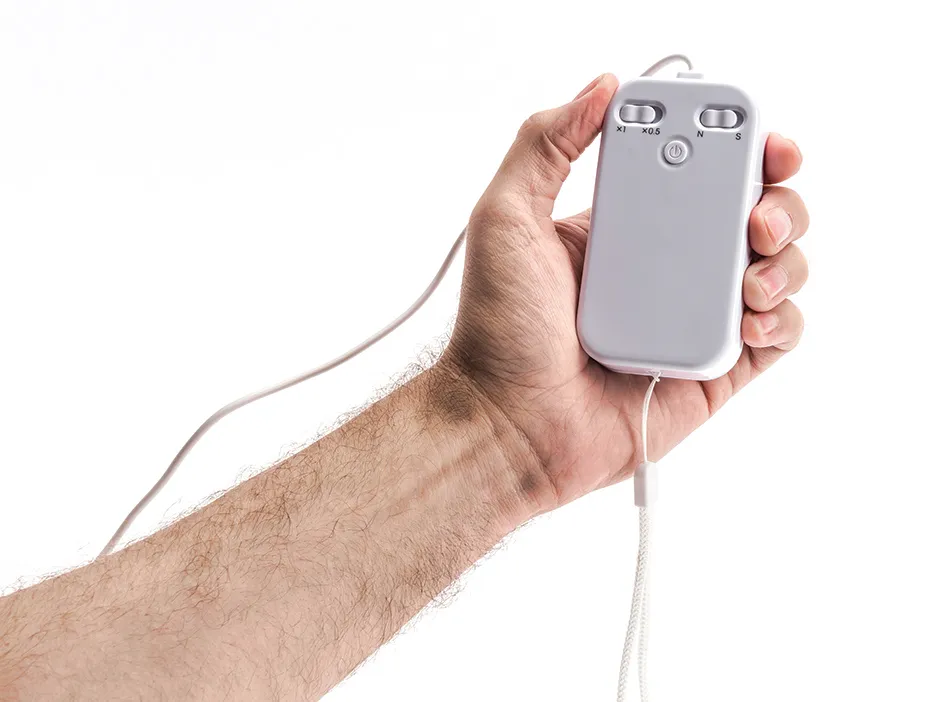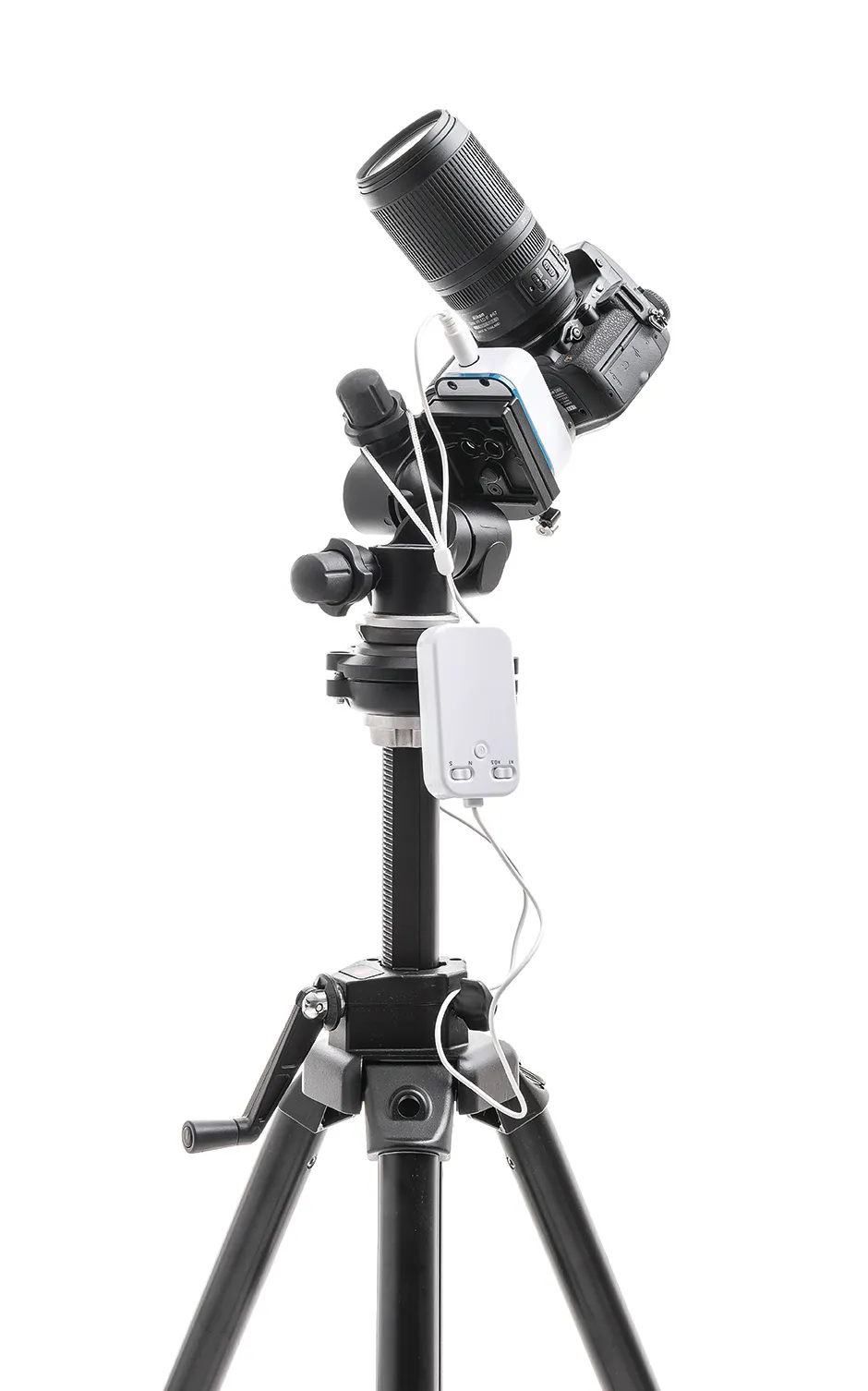Portable, easy to use and easy to set up, star tracker mounts have become fashionable in the past few years and almost all are designed for DSLRs attached to large lenses or small telescopes.
But what if you only want something to allow your camera to track the stars without it being too heavy or cumbersome?
Baader Planetarium has introduced its Nano Tracker mount to Europe.
It is made in Japan by Sightron, which has been marketing it under its own name in the Far East.
This incredibly small, lightweight and easy to use mount may well be just the thing to take away on holiday for some wide-field DSLR imaging.
The Nano Tracker comes as two parts, the actual tracking module and a separate hand controller.
Together they weigh just 480g without batteries and can fit in hand luggage comfortably without taking up much space at all.
You will also need a tripod and a ball head to attach a DSLR.
The tracking module attaches to a standard tripod with a 0.25-inch photo-thread, while another 0.25-inch photo-thread on the top side allows you to attach a ball and socket head.
Its load capacity is up to 2kg so it could easily take, say, a Canon EOS 50D DSLR with its EF 18-55mm lens.
The tracking module also has an integrated polar sighting hole to help you align with Earth’s axis for proper tracking, although we did find that it was difficult viewing through it when we attached the module to our tripod.
Baader suggests attaching a ball head to the tripod, then the tracker and then adding another ball head before the camera to provide clearance for using the sight hole.
Power in your palm

The hand controller is powered by three AA batteries or via a mini USB port.
The controller’s cable slots into the socket on the tracking module and also features a strap so you can attach it to a tripod.
Press the central button on the controller and it automatically starts up in sidereal mode.
The mount can be also set to half sidereal, lunar and solar tracking speeds, and there is a slide to set northern or southern hemisphere.
Note that the ‘speed’ slider only has 1x and 0.5x stops; lunar and solar speeds have to be set by sliding them in conjunction with the northern/southern hemisphere slider.
The manual has full instructions on how to do this.
A blinking green light indicates your choice of tracking mode – it would have been nice if this was a red light.
Using the mount in combination with our Slik tripod, Canon EOS 50D DSLR and an 18-55mm lens, we polar aligned then took a range of images.
With the lens set at 55mm we found we could achieve good pinpoint stars with exposures up to two minutes, while five-minute, wide-angle shots at 18mm gave good results of the Milky Way and the Summer Triangle asterism.
Stacking four such images then processing them brought out a wealth of detail.
We also tried a modded Canon 300D (which has better red sensitivity) with an 18-55mm lens set at 34mm to image Cygnus.
After collecting 16 two-minute exposures at ISO 800 and processing, we were very pleased with the results.
So much so that we swapped to our 70-300mm lens set at 70mm and took 14 one-minute exposures of the North America Nebula, and also the nebulosity around Sadr in Cygnus, with very gratifying results.
We were pleased with the Nano Tracker, but did feel that if the sight hole were situated a little farther out to give better clearance for users of most ordinary tripods it would help more with polar alignment.
Better polar alignment will lead to longer exposures before trailing becomes apparent, however our test results were pleasing all the same.
Such is this unit’s small size and light weight that we can still recommend it heartily.

Incredibly lightweight and portable
The Nano Tracker has to be the smallest and lightest tracking unit on the market.
Its dimensions are a measly 60x98x44mm, whilst the hand controller is only 50x105x22mm.
Individually, they fit into the palm of your hand quite nicely.
Together, and without batteries in the hand controller, they weigh 480g – so incredibly unlikely to tax your hand luggage allowance if you want to take it abroad with you.
We found it easy to hang the controller on our tripod so it was within easy reach, although once the module was tracking we didn’t need to change anything.
For such a small system there is little fuss and it will make astrophotography with a DSLR a lot of fun if you only want to capture images of starry landscapes or wide-field views of the Milky Way.
Added to this, it can also be used for timelapse photography.
It really is a versatile little system.
Drive
Considering the tracker module’s size and lightness it is impressive how well integrated the stepper motor and steel-brass wheel gear are.
You do need to hold the outer drive wheel firmly when attaching a ball head to ensure the teeth are not stripped when tightening it in place.
Polarscope
Polar alignment is vital for good tracking and the Nano Tracker has an integrated zero-magnification sight hole, which is useful for the sighting on Polaris.
Some tripod heads may lie a little close to it, so a second ball head is useful to give more space for looking up through the sight hole.
Tracking module
The tracking module houses the gear system and stepper motors, has the 0.25-inch threaded screw for attaching a ball head and camera on the top and a 0.25-inch thread for attaching the module to a tripod.
A sight hole and hand controller socket completes the module, although there is an additional port not mentioned in the instructions.
Hand controller
On the front of the hand controller are two sliders and a simple power button.
The left slider sets sidereal rate (1x) or half sidereal (0.5x), while the right slider offers northern or southern hemisphere selection.
Power supply
The Nano Tracker requires three AA batteries, which slot into a compartment on the back of the hand controller.
These can give power for up to five hours and in our tests we didn’t need to change them.
Power can also be supplied via a mini USB lead providing 5V, 0.5A power. This cable is not provided.
Price: £199.00
Weight: 400g
Supplier: David Hinds
Telephone: 01525 852696
Website:www.celestron.uk.com
This review originally appeared in the October 2015 issue of BBC Sky at Night Magazine.

